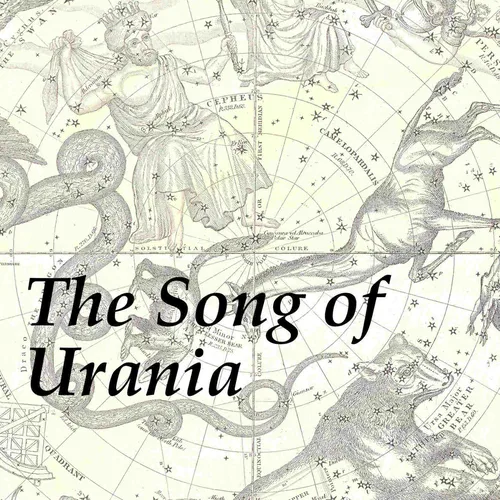
The Song of Urania
A history of astronomy, from antiquity to the present.
- Update frequency
- every 29 days
- Average duration
- 48 minutes
- Episodes
- 47
- Years Active
- 2021 - 2024

Episode 27: Astronomica
In this episode we examine the work of two Roman astrologers to see how Roman astrology worked in practice: Marcus Manilius, who wrote Astronomica, and Firmicus Maternus, who wrote the Matheseos.

Episode 26: Matters of Life & Death in Roman Astrology
As Rome expanded to the East, the cultural influence of the Greeks deepened, and this included a strong interest in astrology. Despite resistance from conservative Romans, by the Imperial Era, astrol…

Episode 25: The Stars of Bethlehem
This month the full moon falls on Three Kings' Day, traditionally a day that celebrates the adoration of the magi, so we investigate the famous Star of Bethlehem story. Through the centuries there ha…

Episode 24: Etruscan & Roman Astronomy
Rome, the great empire of the Mediterranean, is not known for its astronomy. But while it lagged behind other civilizations, it is a mistake to think that they were entirely uninterested in the subje…

Episode 23: The Culmination of Ancient Greek Astronomy
During the half millennium of the Roman Era in Ancient Greece, only two astronomers made any major advances. At the beginning of the Roman Era, Posidonius measured the size of the Earth and discovere…

Episode 22: The Antikythera Mechanism & Friends
In the year 1900 a team of sea sponge divers stumbled upon a shipwreck from the late Hellenistic Era. Among the statues, coins, and jewellery, the salvage crew pulled out a small box covered in moss.…

Episode 21: Hipparchus the GOAT
After briefly examining the astronomy of Timocharis and Aristyllus, who developed the first known stellar catalog, we turn our attention to Hipparchus, who I claim was the greatest astronomer of anci…

Episode 20: The Theory of Epicycles & Deferents
In the Hellenistic Era the astronomer Apollonius of Perga (maybe) developed the model of epicycles and deferents that was to dominate Western astronomy for more than 1500 years. Around the same time,…

Episode 19: The Forerunners of Copernicus
At the dawn of the Hellenistic Age, two Greek astronomers developed radical new cosmologies. Heraclides of Pontica proposed that the Earth rotated on its axis and that Mercury and Venus revolved arou…

Episode 18: Aristotle, Plato's Other Student
Two of Plato's students were notable astronomers. We looked at one of them, Eudoxus, in the last two episodes. In this episode we turn to Plato's other student, Aristotle. Aristotle embellished Eudox…

Episode 17: The Attic Calendar and its Discontents
We turn back the clock and see how a variety of Greek astronomers over the centuries contributed to the Greek calendar, and how Greek politicians ignored their developments. Then we see how the disco…

Episode 16: The Homocentric Spheres of Eudoxus
In working on the problem of doubling the cube, Plato's friend Archytas devised an ingenious solution that involved a three dimensional curve determined by the intersection of a torus with a cylinder…

Episode 15: On Plato's Broad Shoulders
Before leaving the world of the Pre-Socratics, we look briefly at the astronomy of Oenopides, which had a more observational character than many of his contemporaries. Then we turn to Plato, the firs…

Episode 14: The Atomic Philosophers
Two philosophers, Leucippus and Democritus, attempted to synthesize the monist theories of the earlier natural philosophers with the pluralist theories of Empedocles and Anaxagoras. To do this, they…

Episode 13: Ex Uno, Plura
As we transition from the Archaic Period of Greece to the Classical Period, two philosophers, Empedocles and Anaxagoras, rebel against the prevailing dogma of monism and present a new idea — that mat…

Episode 12: The Eleatic School & the Way of Truthiness
After the Median invasion, the Ionian philosopher Xenophanes, a student of the Anaximander, was forced to flee to Elea in Magna Graecia and brought the philosophy of the Ionians to the Eleans. His st…

Episode 11: The So-Called Pythagoreans
We turn to the enigmatic, charismatic philosopher Pythagoras and the following that he inspired. Though Pythagoras is today associated with the Pythagorean theorem, he developed a school whose secret…

Episode 10: The Ionian School
Miletus became a wealthy Greek city during the Archaic Period and developed a thriving intellectual culture which included many of the most important pre-Socratic astronomers. We looked at Thales in …

Episode 9: Thales, through a Glass Darkly
Thales was the first of the Greek astronomers and became known as one of the Seven Sages of Greece. Over the centuries many astronomical discoveries were attributed to him, but what was the reality a…

Episode 8: The Bards Sing of the Skies
We outline the early development of Greek civilization after the Late Bronze Age Collapse and how the unique geography of Greece influenced its culture, and ultimately, its astronomy. Then we explore…